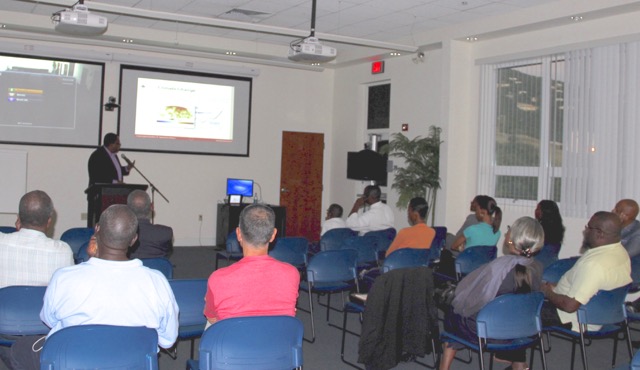
Around a 20 members of the community turned out for day one of the two-day “Climate Change Matters” workshop that was hosted by the University of the Virgin Islands. Among the attendees were persons from the government, environmental non-profits and the development and renewable energy sectors.
Wayne Archibald, director of the Caribbean Green Technology Center and assistant professor of engineering at the UVI, organized the workshop to raise awareness about how climate change is affecting the Caribbean and specifically the Virgin Islands.
Led by climate scientists from the University of the West Indies in Mona, Jamaica, the workshop began with a general introduction to the topic, focusing on the differences between natural climate variability and human-caused climate change.
Natural climate variability accounts for phenomena like El Niño but not for the unprecedented environmental changes being seen today like extreme temperatures, floods and droughts.
“We could see last year’s drought coming because of El Niño predictions, but we didn’t necessarily plan for it right,” said Michael Taylor, climate scientist and professor of physics at University of the West Indies.
Taylor explained that climate change is a long-term change in meteorological variables and accounts for approximately 55 percent of change seen in the Caribbean temperature record over the last 90 years.
“We live in a time of great climate variability and it’s true that climate change is contributing to some of that change in variability. But the wider science community agrees that the human influence is clear even though there are natural cycles of variation,” Taylor said.
Over the last century, the burning of fossil fuels and deforestation have increased the concentration of greenhouse gases like carbon dioxide and methane in the atmosphere. These concentrated gases act like a blanket that covers the earth, which traps heat and leads to warmer temperatures.
In the last century, that human-made global blanket has caused the world to warm by an average of one degree.
“This increase seems small, which is one of the problems of communicating the dangers of climate change,” Taylor said. However small, a slight temperature rise can affect weather patterns like rainfall and even lead to more intense tropical storms.
Taylor said the world’s climate has shifted in six distinctive ways because of climate change, including changes in global temperature, ocean heat content, sea ice and snow cover, sea level rise, precipitation and extreme weather events.
Jayaka Campbell, a research fellow that’s completing his PhD at the University of the West Indies, explained how the science community uses different climate models and global development scenarios to predict how climate change will play out in the future.
“Scenarios are different storylines about how the world will develop and takes into account whether it will be driven by economic or environmental concerns,” Campbell said. If the economy drives decision-making, more greenhouse gases will be admitted through the unregulated burning of fossil fuels.
Due to its complex size, terrain and topography, the Caribbean relies on regional climate models instead of global ones in order to provide finer details for small islands that don’t follow the same norms as large bodies of land.
Across the globe, sea level and global land temperatures have risen over the last century. This trend is witnessed throughout the Caribbean, which has experienced an increase in the number of warm days and warms nights. Overall, that’s resulted in a mean temperature increase of about .1 degree Celsius per decade in the region.
“Throughout the Caribbean, temperatures are increasing and rainfall is more variable,” said Tannecia Stephenson, climate scientist and professor at the University of the West Indies. She added that the Caribbean’s rate of sea level is following the global mean.
Stephenson analyzed data from temperature and precipitation gauges in the Virgin Islands and found that the maximum monthly temperatures have increased at a rate of approximately .4 degree Celsius per decade for the period between 1972 and 1999.
She also noted that there’s a slight upward trend in the intensity, frequency and duration of rainfall events in the territory, though overall the amount of rainfall is decreasing. That’s in line with trend toward drying conditions seen throughout the Caribbean basin, a phenomena that’s expected to continue in the future.
After the workshop, Taylor gave an hour-long public lecture on climate change. UVI President David Hall and Sen. Tregenza Roach welcomed the couple dozen attendees of the event and thanked them for their interest in becoming more informed about climate change, noting how public awareness is crucial to policy implementation.
“Our way of life is inherently climate sensitive,” Taylor said, a theme he emphasized throughout his talk. He said the economy, including agriculture and tourism, and public health are extremely vulnerable to climate change.
“Climate is a part of our day-to-day life, so when it changes, it affects our lives,” Taylor concluded. “We need to plan for when sensitivity becomes vulnerability.”
Day two of the “Climate Change Matters” workshop will take place at UVI from 9 am to 4:30 pm on Wednesday in West Hall, room 330. The public is encouraged to attend the workshop, which will focus on reducing climate change risk and vulnerability in the Virgin Islands.



